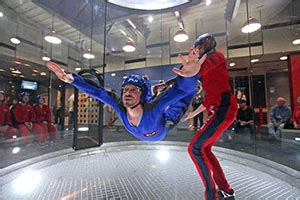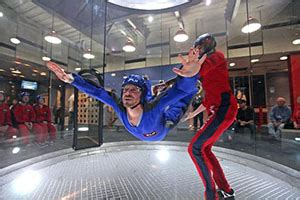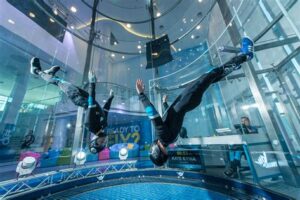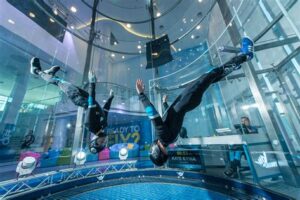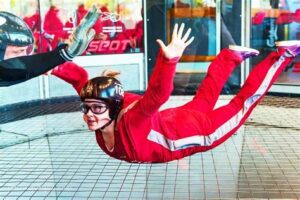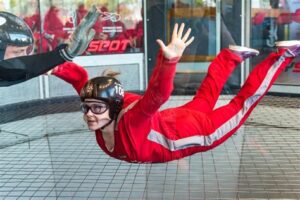Table of Contents
Discover the indoor skydiving restrictions you need to know before taking flight. Uncover the age, weight, and health limitations that may apply to ensure a safe and exhilarating experience. Find out how these restrictions vary among different facilities and get ready for an unforgettable simulated skydiving adventure.
Indoor skydiving, an exhilarating sport that allows individuals to experience the thrill of free falling without jumping off a plane, has gained immense popularity in recent years. However, before you gear up and take flight in the wind tunnel, it is crucial to familiarize yourself with the various restrictions that govern this heart-pounding activity. Whether you are a first-time flyer or a seasoned pro, understanding these limitations ensures both your safety and the smooth operation of the facility. So, let’s dive into the world of indoor skydiving restrictions and discover how they shape this adrenaline-fueled adventure!
Introduction
Indoor skydiving is an exciting and adrenaline-pumping activity that allows individuals to experience the thrill of freefalling in a controlled environment. However, like any other extreme sport, there are certain restrictions and guidelines that participants must adhere to ensure their safety and the safety of others. In this article, we will explore some of the common indoor skydiving restrictions and instructions that every enthusiast should be aware of before taking the plunge.
Age Restrictions
One of the primary restrictions for indoor skydiving is age. Most indoor skydiving facilities require participants to be at least 3 years old, while some may have a higher age limit. This restriction ensures that individuals have the physical and mental capacity to understand and follow the necessary instructions during the activity. Additionally, minors are often required to have parental consent before participating in indoor skydiving.
Health Restrictions
Indoor skydiving is a physically demanding activity, and as such, certain health restrictions may apply. Individuals with heart conditions, high blood pressure, back or neck injuries, or those who are pregnant are often advised against participating in indoor skydiving. These restrictions aim to prevent any potential health complications that may arise during the activity.
Weight Restrictions
Weight restrictions are another important consideration when it comes to indoor skydiving. Most facilities have a maximum weight limit to ensure the safety and comfort of participants. The weight limits may vary between different facilities, but they are typically in place to ensure that the airflow within the wind tunnel remains optimal for a safe and enjoyable experience.
Attire Restrictions
Proper attire is crucial for indoor skydiving to ensure both safety and comfort. Participants are usually required to wear comfortable clothing that allows freedom of movement, such as athletic wear or jumpsuits provided by the facility. Loose jewelry, watches, and other accessories that may pose a risk of getting caught in the wind tunnel are generally not allowed.
Instructional Briefing
Prior to participating in indoor skydiving, all participants are required to attend an instructional briefing. This briefing covers important safety information, body positioning techniques, hand signals, and what to expect during the experience. It is essential to pay close attention and follow the instructions provided to ensure a safe and enjoyable flight.
Physical Preparation
While indoor skydiving may not require as much physical exertion as traditional skydiving, it is still important to be physically prepared. Stretching exercises before the flight can help warm up the muscles and improve flexibility, reducing the risk of strain or injury. It is also advisable to inform the instructor about any pre-existing physical conditions to ensure appropriate modifications can be made.
No Alcohol or Drug Consumption
To ensure the safety of all participants, indoor skydiving facilities strictly prohibit the consumption of alcohol or drugs before or during the activity. These substances can impair judgment, coordination, and reaction times, increasing the likelihood of accidents or injuries. It is essential to be in a clear state of mind and free from any substances that may affect cognitive abilities.
Supervision for Minors
For participants who are under the age of 18, supervision by a responsible adult is typically required. This ensures that minors follow the instructions provided by the instructors and behave in a safe manner. The adult supervisor may also need to sign any necessary waivers or consent forms on behalf of the minor.
Respecting Staff Instructions
Throughout the indoor skydiving experience, it is important to respect and follow the instructions provided by the staff. They are trained professionals who have extensive knowledge and experience in ensuring the safety of all participants. Ignoring or disregarding their instructions may put oneself and others at risk, so it is crucial to listen attentively and comply with their guidance.
Conclusion
Indoor skydiving restrictions are in place to prioritize the safety and well-being of participants. By adhering to these guidelines, individuals can enjoy the exhilarating experience of indoor skydiving while minimizing the risks involved. Remember to check the specific restrictions and requirements of the facility you plan to visit before booking your flight, and always prioritize safety above all else.
Indoor Skydiving Restrictions: Instructions and Guidelines
When it comes to indoor skydiving, there are several restrictions and guidelines that must be followed to ensure the safety and well-being of all participants. By adhering to these restrictions, you can have an enjoyable and risk-free experience. Let’s take a closer look at each restriction and guideline:
1. Age Restrictions:
Only individuals aged 3 and above are permitted to participate in indoor skydiving. It is important to note that children under the age of 18 must be accompanied by a legal guardian or parent. This ensures that young participants have appropriate supervision throughout the activity.
2. Weight Restrictions:
To ensure safe flight, participants must weigh less than 300 pounds. Exceeding this weight limit may compromise the effectiveness of the wind tunnel and pose a risk to both the participant and instructors. Therefore, it is crucial to adhere to this weight restriction for the safety of everyone involved.
3. Health Restrictions:
Participants with pre-existing medical conditions such as heart problems, back or neck injuries, epilepsy, or those who are pregnant are advised not to engage in indoor skydiving. It is essential to consult with a physician before participating in this activity to ensure that it does not pose any risks to your health. Your well-being is our utmost concern.
4. Equipment Restrictions:
To maintain safety standards, participants must follow all safety guidelines provided by the instructors. This includes wearing appropriate clothing, such as shorts or pants and a t-shirt, which allows for ease of movement. Additionally, any loose items such as jewelry, hats, or scarves should be removed before entering the wind tunnel to prevent any accidents or distractions during the experience.
5. Physical Restrictions:
We understand that individuals with mobility impairments or physical disabilities may have specific requirements. If you fall into this category, it is recommended to contact the facility in advance to discuss your needs. Accommodations can be made to ensure your safety and comfort during the indoor skydiving experience.
6. Behavior Restrictions:
To maintain a safe and enjoyable environment for all participants, it is crucial to follow all instructions given by the instructors and behave responsibly throughout the activity. Failure to adhere to guidelines or engaging in disruptive behavior may result in immediate removal from the wind tunnel. Cooperation and respect for others are essential for everyone’s well-being.
7. Weather and Facility Restrictions:
Weather conditions can affect indoor skydiving experiences. In case of extreme weather or unforeseen circumstances, the facility reserves the right to reschedule or cancel sessions to ensure the safety of participants and staff. It is important to be aware of and comply with all facility rules and regulations for a smooth and safe experience.
8. Training and Certification:
Prior to engaging in indoor skydiving, all participants must undergo a mandatory training session. This session serves to familiarize individuals with the basic techniques and safety procedures of indoor skydiving. Completion of the training and a satisfactory performance evaluation are necessary before participating in further sessions or attempting advanced maneuvers. This ensures that all participants have the necessary skills and knowledge to enjoy a safe and thrilling experience.
Remember, safety is our top priority. By following these restrictions and guidelines, you can have a memorable and risk-free indoor skydiving experience. If you have any questions or concerns, do not hesitate to reach out to the facility staff. Enjoy the thrill of indoor skydiving while prioritizing your safety!
Indoor skydiving is an exhilarating and adventurous activity that allows individuals to experience the thrill of skydiving in a controlled environment. However, to ensure the safety of participants, certain restrictions and guidelines must be followed. Here is a point of view about indoor skydiving restrictions, using an instructional voice and tone:
-
Age restrictions:
-
Participants must be at least 3 years old to engage in indoor skydiving.
-
For children aged 3-17, a parent or guardian must sign a consent form.
-
-
Physical restrictions:
-
Individuals with pre-existing medical conditions such as heart problems, back or neck injuries, or any condition that may be aggravated by the activity are advised not to participate.
-
Pregnant women are also restricted from indoor skydiving due to potential risks.
-
-
Weight limitations:
-
There is typically a maximum weight limit for participants, usually around 250 pounds (113 kilograms).
-
This restriction is in place to ensure the safety and comfort of both the participant and the instructor.
-
-
Training requirements:
-
Prior to participating in indoor skydiving, all participants are required to undergo a training session.
-
This session includes learning basic body movements, hand signals, and safety procedures.
-
-
Proper attire:
-
Participants must wear appropriate clothing, including sneakers or athletic shoes.
-
Jewelry, loose accessories, and items that may fall off during the activity should be removed.
-
-
Follow instructor’s guidance:
-
During the indoor skydiving experience, it is crucial to listen attentively to the instructor’s guidance and follow their instructions.
-
Participants should maintain proper body positioning and avoid sudden movements that may disrupt their stability.
-
By adhering to these restrictions and guidelines, participants can enjoy a safe and memorable indoor skydiving experience. Remember, safety should always be the top priority when engaging in any adventurous activity.
Thank you for taking the time to visit our blog and learn more about indoor skydiving restrictions. We hope that the information provided has been helpful in understanding the safety measures and guidelines that are in place to ensure a thrilling yet secure experience for all participants.Indoor skydiving is an exhilarating activity that allows individuals to experience the sensation of freefalling in a controlled environment. However, it is important to note that there are certain restrictions and limitations that need to be followed to ensure the safety of both the participants and the instructors.Firstly, age restrictions are one of the most crucial factors when it comes to indoor skydiving. Most facilities require participants to be at least 3 years old, with some having a minimum age requirement of 5 or 6 years old. This is because younger children may not have the necessary coordination and understanding to follow instructions during the flight. Additionally, there may be height and weight restrictions in place to ensure proper body positioning and balance during the activity.
Furthermore, individuals with certain medical conditions or physical limitations may also face restrictions when it comes to indoor skydiving. It is important for participants to be in good health and free from any conditions that may pose a risk during the flight. Conditions such as heart problems, high blood pressure, epilepsy, and recent surgeries may prevent individuals from participating in indoor skydiving. Pregnant women are also advised against participating due to the potential risks involved.
Lastly, it is crucial for participants to follow all safety instructions and guidelines provided by the facility and instructors. This includes wearing the appropriate attire, such as comfortable clothing and closed-toe shoes, and removing any loose items or accessories that may pose a risk during the flight. Additionally, participants must listen carefully to the pre-flight briefing and follow the instructions given by the instructors during the flight to ensure a safe and enjoyable experience.
In conclusion, indoor skydiving is a thrilling activity that offers a unique experience for individuals of all ages. However, it is important to be aware of and adhere to the restrictions and guidelines set in place to ensure the safety and well-being of everyone involved. By following these restrictions and instructions, you can make the most out of your indoor skydiving experience and create lasting memories. Stay safe and enjoy the adventure!
Video Indoor Skydiving Restrictions
People Also Ask about Indoor Skydiving Restrictions:
-
Are there any age restrictions for indoor skydiving?
Yes, most indoor skydiving facilities have age restrictions in place. The minimum age requirement can vary but is typically around 3 to 4 years old. Some facilities may also have a maximum age limit for safety reasons.
-
Do I need any prior experience to try indoor skydiving?
No prior experience is necessary for indoor skydiving. Professional instructors will guide you through the process and provide the necessary training and equipment to ensure a safe and enjoyable experience.
-
Are there any weight restrictions for indoor skydiving?
Yes, there are usually weight restrictions for indoor skydiving. These restrictions are in place to ensure the safety of participants and to comply with the limitations of the equipment. The weight limits may vary among different facilities, but generally range from around 250 to 300 pounds.
-
Can people with disabilities participate in indoor skydiving?
Many indoor skydiving facilities are accessible to people with disabilities. However, it is recommended to contact the specific facility beforehand to discuss any special requirements or accommodations that may be needed. The facility staff will be able to provide guidance based on individual needs.
-
Is there a dress code for indoor skydiving?
While there is no strict dress code for indoor skydiving, it is advisable to wear comfortable clothing that allows for ease of movement. Avoid wearing loose items, such as scarves or jewelry, that could potentially get caught in the wind tunnel. Additionally, closed-toe shoes are usually required for safety reasons.
Please note that these restrictions and guidelines may vary depending on the specific indoor skydiving facility. It is always recommended to check with the facility directly for their precise rules and regulations before planning your visit.

